IDT Technology BPW800 Blood Pressure Wrist User Manual RGR126 COVER indd
IDT Technology Limited Blood Pressure Wrist RGR126 COVER indd
Users Manual

User Manual
Talking Blood Pressure Monitor
Model: BPW800
使用指南
語音腕式電子血壓計
型號: BPW800
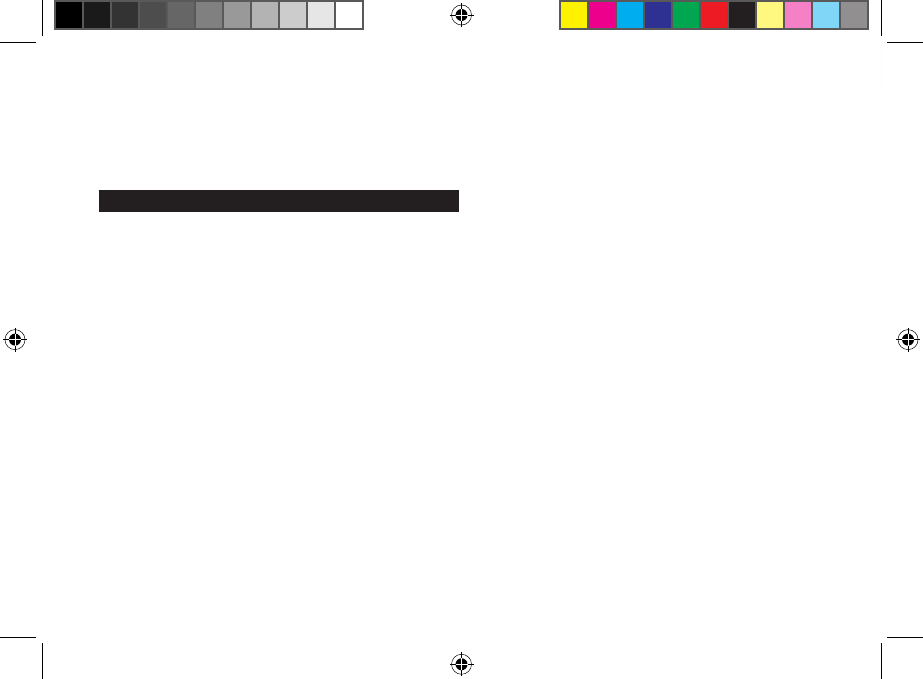
EN
1
TALKING BLOOD
PRESSURE MONITOR
MODEL: BPW800
USER MANUAL
CONTENTS
Introduction .................................................................... 2
Key features ................................................................... 2
Front view.................................................................. 2
Rear view .................................................................. 3
LCD symbols ............................................................. 3
Safety and care instructions ......................................... 4
Safety precautions .................................................... 4
Caring for your blood pressure monitor..................... 4
About blood pressure .................................................... 4
How the blood pressure monitor works ...................... 6
Getting started ............................................................... 6
Installing and replacing the batteries......................... 6
Setting date and time ................................................ 7
Positioning the wrist cuff ........................................... 7
Preparing to take blood pressure measurement ........ 8
Taking a measurement .................................................. 8
Voice announcement................................................. 9
Memory ......................................................................... 10
Recalling measurements stored in memory ............ 10
Clear records ................................................................ 10
Deleting a single record .......................................... 10
Deleting all records ..................................................11
Data transmission ........................................................ 11
Unique device ID ..................................................... 12
Troubleshooting ........................................................... 12
Technical specications .............................................. 13
About Oregon Scientic .............................................. 14
Information about the CE mark .................................. 14
Symbol description(s) ................................................. 14
Blood pressure log book ............................................. 14
FCC statement .............................................................. 15
BPW800_EN_R8.indd 1 2011/6/8 7:06:51 PM
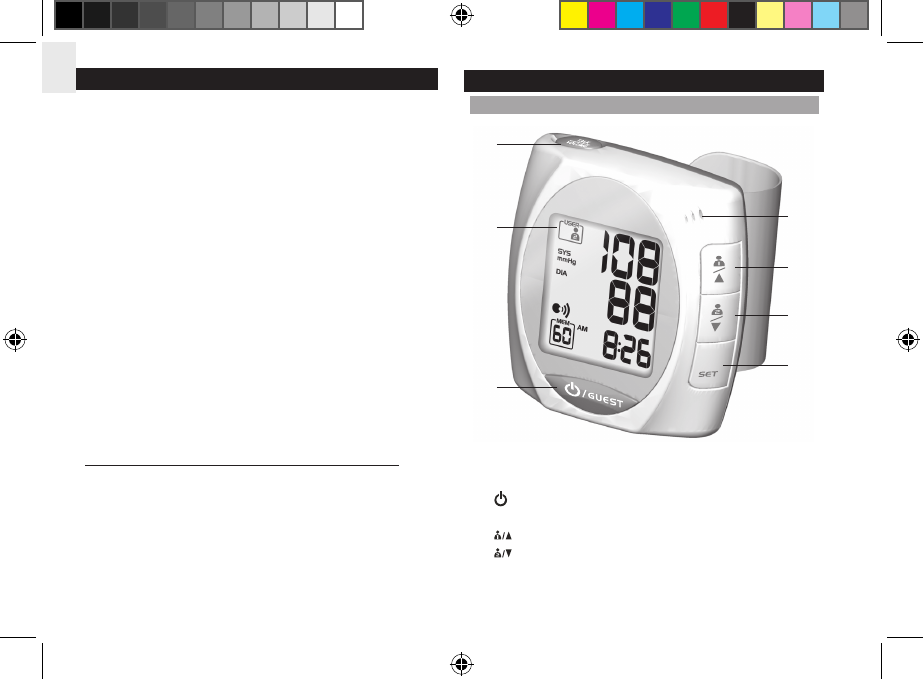
EN
2
INTRODUCTION
Thank you for selecting the Oregon ScienticTM Talking Wrist
Type Blood Pressure Monitor (BPW800). The BPW800
features voice announcement and playback of blood
pressure measurements for added convenience and has
been designed to provide you with many years of reliable
service. The unit can help you measure and track the
following metrics:
• Systolic pressure
• Diastolic pressure
• Mean arterial pressure
• Pulse rate
• Historic record of up to 30 measurements per user
(maximum 2 users)
Readings taken by the blood pressure monitor are equivalent
to those obtained by a trained observer using the cuff and
stethoscope auscultation method. Clinical performance
were successfully done against ANSI/AAMI SP10 and
international protocol, and the B.H.S.( British Hypertension
Society) has rated this product “recommended for clinical
and home use”, the highest grading available for blood
pressure monitors. Please refer to BHS website
http://www.bhsoc.org/bp_monitors/automatic_wrist.stm
This manual contains important safety and care information,
and provides step-by-step instructions for using the
product.
Read the manual thoroughly before using the product.
KEY FEATURES
FRONT VIEW
1
2
3
5
4
6
7
1. TALK / VOLUME button
2. LCD
3. ON / OFF and GUEST button
4. Speaker
5. USER 1 / UP ARROW button
6. USER 2 / DOWN ARROW button
7. SET button
BPW800_EN_R8.indd 2 2011/6/8 7:06:53 PM
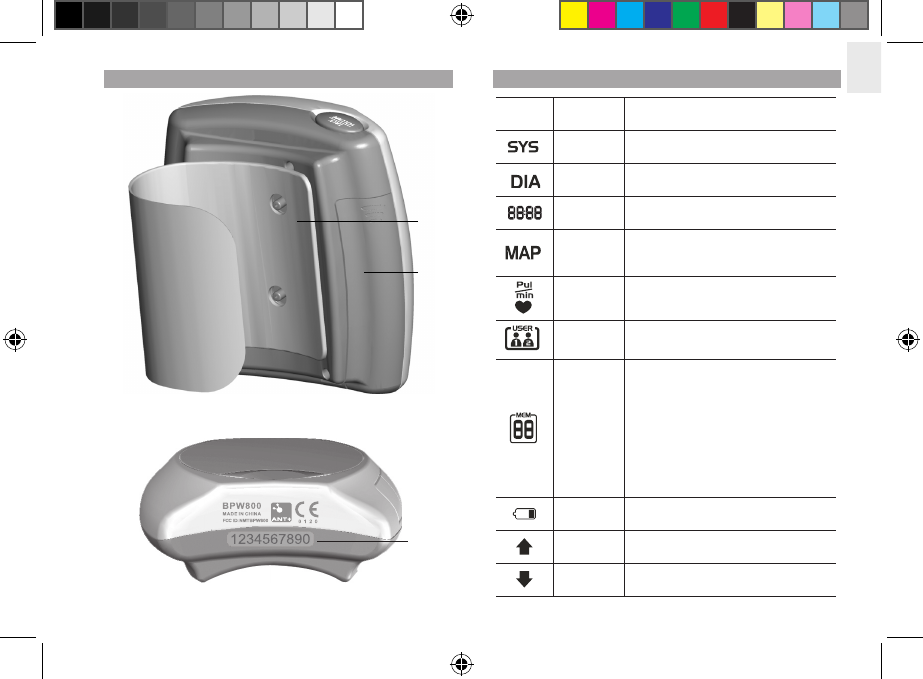
EN
3
REAR VIEW
2
1
1. Wrist cuff
2. Battery compartment
3
3. Unique Device ID
LCD SYMBOLS
SYMBOL DESCRIP-
TION EXPLANATION
Systolic
pressure
The highest blood pressure
measured
Diastolic
pressure The lowest blood pressure measured
Time (hour:
minutes) Current time
Mean
arterial
pressure
Average blood pressure measured
(see “What is Mean Arterial Pressure
(MAP)?” for more information)
Pulse Pulse rate per minute
User Shows which user prole (1 or 2 is
being displayed)
Memory
If “MEM” shows, the displayed
measurement value is from the
memory and not necessarily from the
last reading.
If “MEM” ashes, there are 24 or
more records per user which have
not been uploaded. User is reminded
to upload the data to the network to
prevent records being erased.
Weak
battery
Batteries are low and need to be
replaced
Inating Unit is inating with air to obtain the
needed level of pressure
Deating Wrist cuff air is exhausting or
deating
BPW800_EN_R8.indd 3 2011/6/8 7:06:59 PM
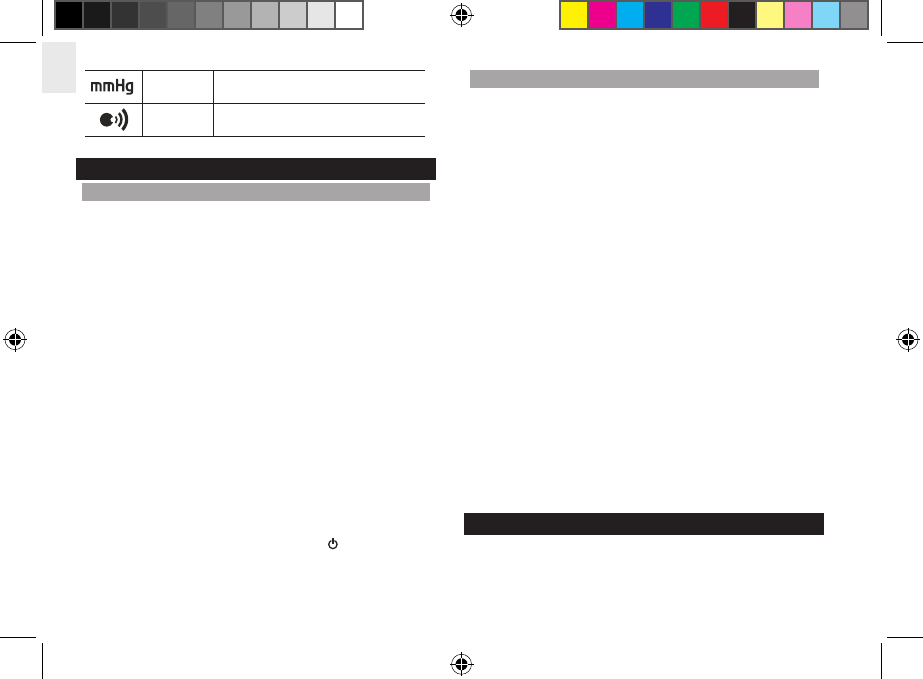
EN
4
Millimeter(s)
of mercury Measurement unit for blood pressure
Voice
activation
Voice announcing your blood
pressure measured
SAFETY AND CARE INSTRUCTIONS
SAFETY PRECAUTIONS
Please observe the following safety precautions when
setting up and using your blood pressure monitor.
• This device is intended for adult use only.
• This device is intended for non-invasive measuring and
monitoring of arterial blood pressure. It is not intended
for use on extremities other than the wrist or for functions
other than obtaining a blood pressure measurement.
• Do not confuse self-monitoring with self-diagnosis. This
unit allows you to monitor your blood pressure. Do not
begin or end medical treatment based solely on the
measurements of this device. Consult a physician for
treatment advice.
• If you are taking medication, consult your physician to
determine the most appropriate time to measure your
blood pressure. Never change a prescribed medication
without consulting your physician.
• This unit is not suitable for continuous monitoring during
medical emergencies or operations.
• If the cuff pressure exceeds 40 kPa (300 mmHg), the
unit will automatically deate. Should the cuff not deate
when pressures exceeds 40 kPa (300mmHg), detach
the cuff from the wrist and press the button to stop
ination.
• To avoid measurement errors, carefully read this manual
before using the product.
CARING FOR YOUR BLOOD PRESSURE MONITOR
To ensure you receive the maximum benet from using this
product, please observe the following care guidelines.
• When not in use, store the unit in a dry place away from
direct sunlight.
• Do not immerse the unit in water. If it comes in contact
with water, dry it immediately with a soft lint-free cloth.
• Use a soft, slightly moistened cloth to wipe the unit and
cuff. Do not use abrasive or corrosive cleaning agents,
as these may cause damage.
• Remove the batteries whenever you are planning to
store the unit for a long period of time.
• When replacing batteries, use new batteries as specied
in this user manual. Do not mix new and old batteries.
• Do not place objects such as stickers on the wrist cuff or
unit, as these may impair the measurement.
• Do not subject the unit to excessive force, shock, dust,
temperature changes, or humidity. Such treatment may
result in malfunction, a shorter electronic life span,
damaged batteries, or distorted parts.
• Do not tamper with the internal components. Doing so will
terminate the product warranty and may cause damage.
• The unit contains no user- serviceable parts.
• If you no longer need to use this product, protect the
environment by bringing it to your dealer or designated
collection point for proper disposal.
ABOUT BLOOD PRESSURE
What is blood pressure?
Blood pressure is the force generated by the blood against
the walls of arteries during cardiac contraction and relaxation
(e.g., the pumping action of the heart).
BPW800_EN_R8.indd 4 2011/6/8 7:07:00 PM
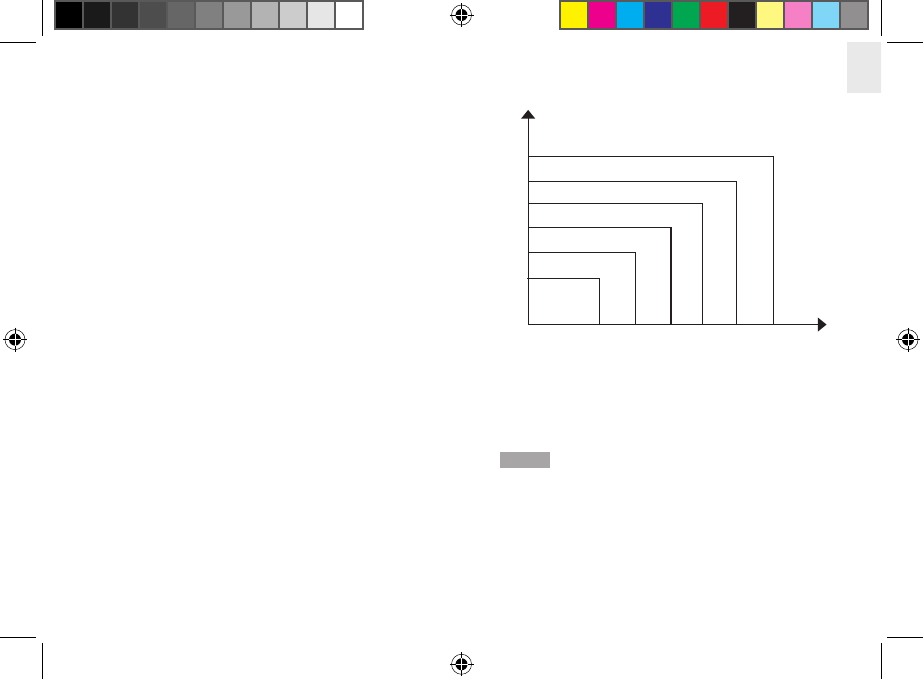
EN
5
What are systolic pressure and diastolic pressure?
When ventricles contract and pump blood out of the heart,
blood pressure reaches its maximum value. This highest
pressure in the cycle is known as systolic pressure. When
the heart relaxes between heartbeats, the lowest blood
pressure is diastolic pressure.
What is mean arterial pressure (MAP)?
The mean arterial pressure (MAP) is the average pressure
that forces blood through the arteries. It is not the average
of the systolic and diastolic blood pressure; rather, MAP
corresponds to a state of balance between the compressive
and expansive forces acting on the arterial wall when there
is no distension outward or inward. MAP is an excellent
way to evaluate the stress on the walls of your blood
vessels, and can be used to evaluate excessive load on
the cardiovascular system. Show your MAP history to your
doctor to provide additional information that may help him or
her understand your situation.
Why measure your blood pressure?
Blood pressure measurement can highly reect one’s health
condition. High blood pressure is potentially linked to serious
illnesses such as stroke, heart disease and kidney failure.
Since there is no symptom most of the time, many
hypertensive people do not realize they are at risk until their
health is seriously threatened.
What is the standard blood pressure classication?
The gure illustrates the blood pressure classication made
by World Health Organization (WHO) and International
Society of Hypertension (ISH) in 1999.
110
100
95
90
85
80
)
g
H
m
m
(
e
rus
ser
p
d
oolb
ci
l
o
ts
a
i
D
120 130 140 150 160 180
Systolic blood pressure (mmHg)
Grade 3 hypertension (severe)
Grade 2 hypertension (moderate)
Grade 1 hypertension (mild)
Subgroup: borderline
High-normal Blood Pressure
Normal Blood Pressure
Optimal Blood
Pressure
Reference material: 1999 World Health Organization-
International Society of Hypertension Guidelines for the
management of hypertension, Journal of Hypertension,
1999, 17(2): 151-183.
NOTE
• Blood pressure is considered high when either the diastolic
or systolic blood pressure value exceeds the normal range.
When a patient’s systolic and diastolic blood pressures fall
into different categories, the higher category should apply.
• Only a physician can tell you your normal blood pressure
range and the point at which you are at risk. Consult your
physician to obtain these values. If the measurements
taken with these products fall outside the range, consult
your physician.
BPW800_EN_R8.indd 5 2011/6/8 7:07:01 PM
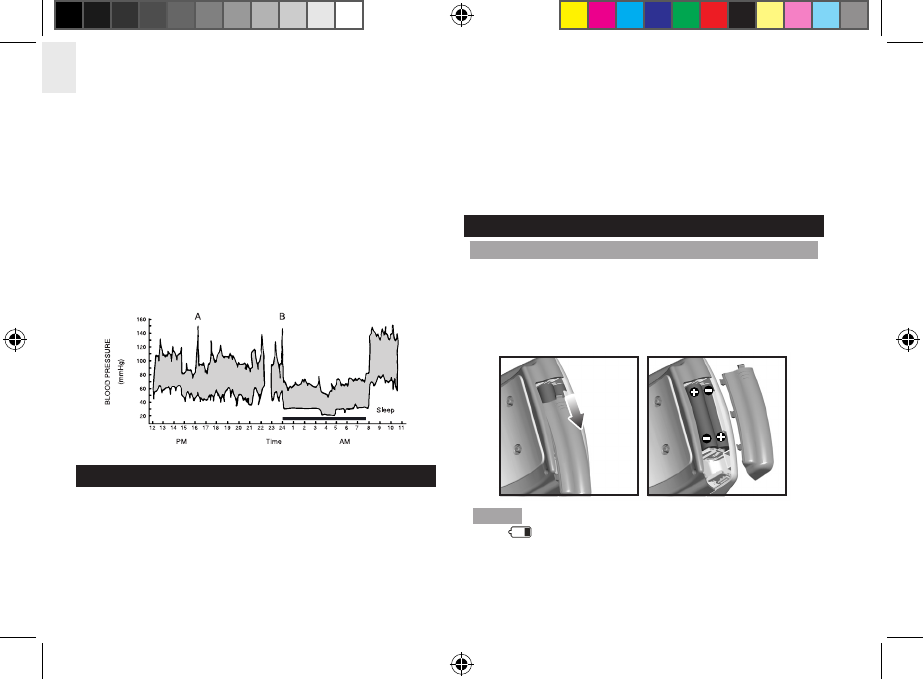
EN
6
Why does my blood pressure uctuate throughout the
day?
Individual blood pressure varies greatly both on a daily and
a seasonal or temperature basis. These variations may be
more pronounced in hypertensive patients. Normally the
blood pressure rises while at work and is at its lowest during
sleep.
The graph below illustrates the variations over a single day
with measurement taken every 5 minutes. The thick line
represents sleep time. The rises in blood pressure at 4PM
(A in the graph) and 12AM (B in the graph) correspond to
an attack of pain and sexual intercourse (Beven, Honour &
Stott, Clin. Sci. 36:329, 1969).
HOW THE BLOOD PRESSURE MONITOR WORKS
This product uses the Oscillometric Measuring method to
detect your blood pressure. Before every measurement,
the unit establishes a “zero pressure” equivalent to the air
pressure.
Then it starts inating the wrist cuff to 180mmHg or higher
until it senses that it has blocked your blood in the artery.
After that, the deation process starts, during which time
the unit detects pressure oscillations generated by beat-to-
beat pulsatile, which is used to determine the systolic, mean
and diastolic pressure, and also your pulse rate. Any motion
during this period will result in an incorrect measurement.
After all readings are determined and displayed on the LCD,
the measurement is nished and the wrist cuff automatically
deates.
GETTING STARTED
INSTALLING AND REPLACING THE BATTERIES
1. Slide off the battery cover.
2. Install the batteries by matching the correct polarity, as
shown below. Always use the correct battery type (2
alkaline LR03 AAA-size).
3. Replace the cover.
NOTE Replace the batteries whenever the weak battery
mark shows, the display is dim, or the display does not
illuminate when the power is on. Replace all the batteries
at the same time - it is dangerous to mix old and new
batteries.
BPW800_EN_R8.indd 6 2011/6/8 7:07:02 PM
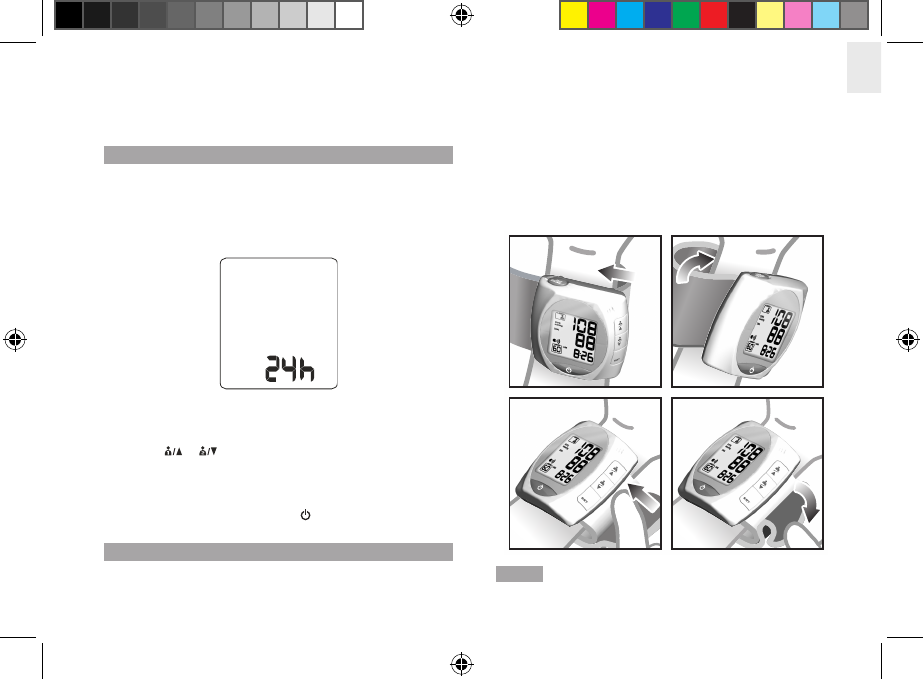
EN
7
Contact your local waste disposal authority for instructions
on how to dispose of used batteries. Used batteries can be
harmful to the environment, and should not be thrown out
with household trash.
SETTING DATE AND TIME
It is important to set the clock before using your blood
pressure monitor, so that a time stamp can be assigned to
each record that is stored in the memory.
1. When the unit is off, press and hold SET for 2 seconds
to enter the setting mode.
2. The setting order is as follows: 12/24 hour format, hour,
minute, year, month/day or day / month format, month
and date.
3. Press or to increase / decrease a value or change
the setting.
4. Press SET to accept the change and switch to the next
setting.
5. When you are nished, press to exit the setup menu.
POSITIONING THE WRIST CUFF
It is important to properly position the wrist cuff to ensure
that you receive an accurate reading.
1. Remove all accessories (watch, bracelet, etc.) from your
left wrist. If your physician has diagnosed you with poor
circulation in your left arm, use your right wrist.
2. Roll or push up your sleeve to expose the skin.
3. Apply the cuff to your left wrist with your palm facing up.
4. Position the edge of the cuff about 0.4 inches (1cm) from
the bottom of your palm.
5. Fasten the wrist cuff around your wrist, leaving no extra
room between the cuff and your skin. If the cuff is too
loose, the measurement will not be accurate.
NOTE Graphics may not exactly match product.
BPW800_EN_R8.indd 7 2011/6/8 7:07:04 PM
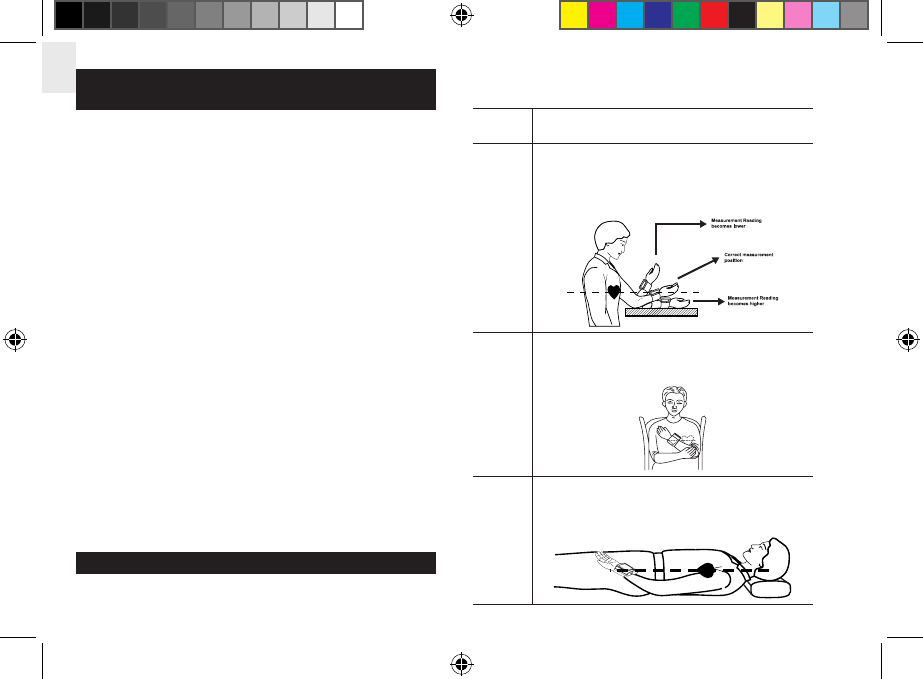
EN
8
PREPARING TO TAKE BLOOD PRESSURE
MEASUREMENT
You can choose to take your blood pressure while sitting
or lying down. Below are some helpful tips for taking a
measurement:
• Be sure to set the clock before taking your rst
measurement, or whenever you replace the batteries, so
that the date and time are stored in the memory with your
history. For instructions, refer to “Setting date and time”
section.
• It is important to relax when taking your blood pressure.
Try to take a 15-minute rest before you begin.
• Do not lean backward or bend your wrist inward while
taking a measurement.
• Avoid talking or moving your ngers and hand while
taking a measurement. Rapid movements or other
activities may alter your reading.
• Wait at least an hour before taking your blood pressure
if you have just eaten a large meal.
• Do not smoke or drink alcohol before taking your blood
pressure.
• Do not measure your blood pressure if you are under
stress.
• Wait at least 3 minutes between measurements. This
allows your blood circulation to recover.
• For a meaningful comparison, try to measure under
similar conditions. For example, take daily measurements
at approximately the same time, on the same wrist, or as
directed by a physician.
TAKING A MEASUREMENT
1. Choose the position from which you wish to measure
- sitting or lying down.
2. Position your body so that your wrist is parallel with your
heart, using the chart and illustrations below as a guide.
IF YOU
ARE... THEN...
Sitting
down
with an
armrest
Place your elbow on a table, using an object
as a support under your forearm. Your wrist
should be parallel to your heart, with the palm
facing up.
Sitting
down
with no
armrest
Place your arm across your chest with the
wrist parallel to your heart. Hold your elbow
with the other hand.
Lying
down
Position your wrist on a support, cushion, or
your thigh so that it is parallel with your heart
with the palm facing up.
BPW800_EN_R8.indd 8 2011/6/8 7:07:05 PM
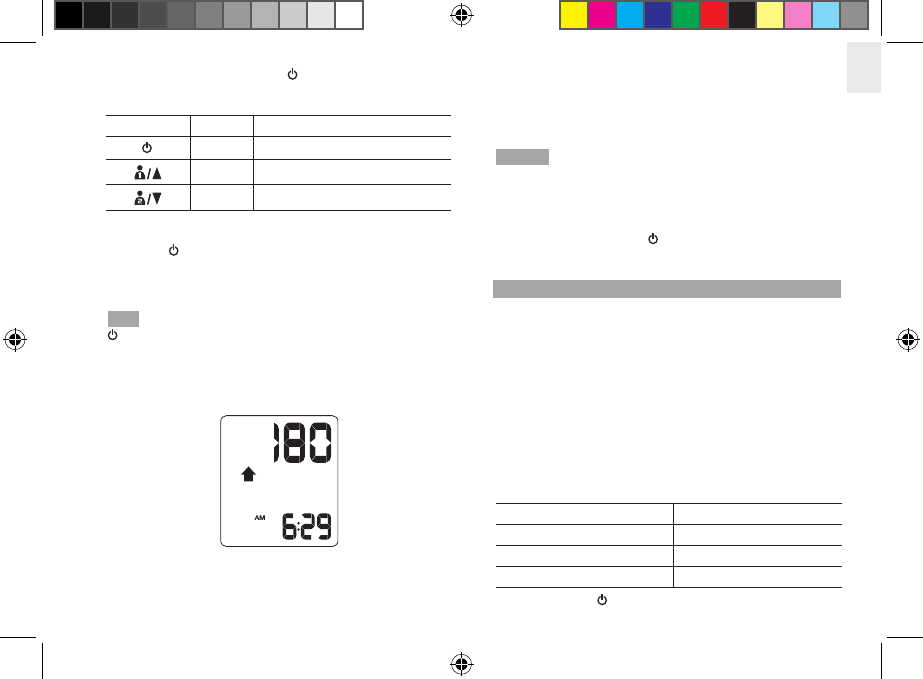
EN
9
3. Relax your hand and press to turn on the unit.
4. Select user:
Press User Memory
Guest No memory stored
User 1 Memory stored under User 1
User 2 Memory stored under User 2
A voice will prompt you to sit in the correct position.
5. Press again to begin measurement. A voice will
remind you to relax and remain still. Wrist cuff will begin
inating automatically to measure blood pressure.
TIP To stop the measurement process at any time, press
.
Once the pressure reaches a certain level, it will slowly
deate until the measurement results are displayed on the
LCD.
This unit can intelligently adjust the cuff pressure and inate
to a higher-pressure level (>180 mmHG) when needed.
Your systolic and diastolic pressure readings ash on the
LCD, followed by MAP and pulse per minute readings every
2 seconds. At the same time, your measurement results and
the blood pressure classication will also be announced.
NOTE The unit automatically attempts to send record
wirelessly to the hub. “PC” will appear on the screen. If data
transmission fails, “Err” will appear on the screen.
The unit switches off 1 minute after taking a measurement.
To save battery life, press as soon as you are nished to
turn off the unit.
VOICE ANNOUNCEMENT
The BPW800 features voice playback during and after
blood pressure measurement results, as well as general
instructions to help you prepare for taking measurements.
When the unit has nished taking your measurement,
your blood pressure readings, pulse and blood pressure
classication are announced.
To repeat announcement: Press TALK / VOLUME.
To change volume:
1. Press and hold TALK / VOLUME.
2. Press TALK / VOLUME repeatedly to select desired
volume.
Volume setting Volume level
0 Mute
1 Low
2 High
3. To exit, press or SET.
BPW800_EN_R8.indd 9 2011/6/8 7:07:06 PM
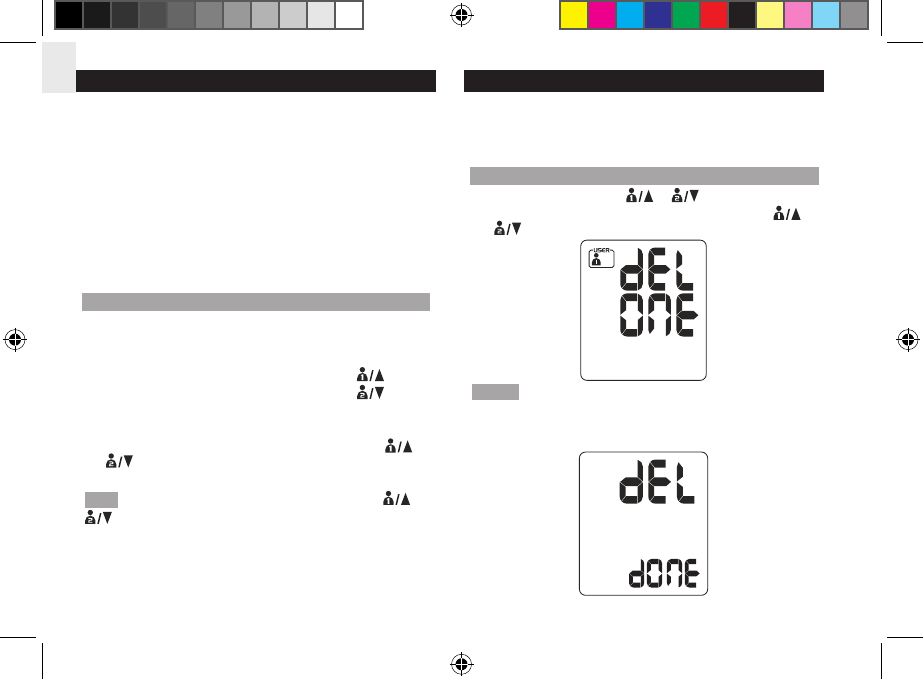
EN
10
MEMORY
This device can record up to 30 records per user. The most
recent record (1) is shown rst. Each new measurement is
assigned to the rst (1) entry in the user record selected. All
other records are pushed back one digit (e.g., 2 becomes 3,
and so on), and the last record (30) is dropped from the list.
For ease of reference, the date when the measurement was
taken is shown with each record.
Memory records will be kept even when the batteries
become exhausted and are replaced.
RECALLING MEASUREMENTS STORED IN MEMORY
Ensure unit is off.
Select user:
• To view a history of User 1’s records, press .
• To view a history of User 2’s records, press .
View records:
• Press the corresponding user button repeatedly ( or
) to see additional records.
TIP Press and hold corresponding user button ( or
) to quickly toggle through all the entries.
Hear record:
• Press TALK / VOLUME.
CLEAR RECORDS
You have the option of deleting your latest measurement
record or entire measurement history. This is useful if
measurements have not been accurately recorded and
need to be recorded again.
DELETING A SINGLE RECORD
1. When unit is off, press or to select user.
2. Press the corresponding user button repeatedly ( or
) to navigate to record to be deleted.
NOTE The most recent record (1) is shown rst.
3. Press and hold SET. “deL OnE” will be displayed on the
LCD screen.
4. a. Press and hold SET again to delete.
“deL dOnE” indicates record has been successfully deleted.
BPW800_EN_R8.indd 10 2011/6/8 7:07:08 PM
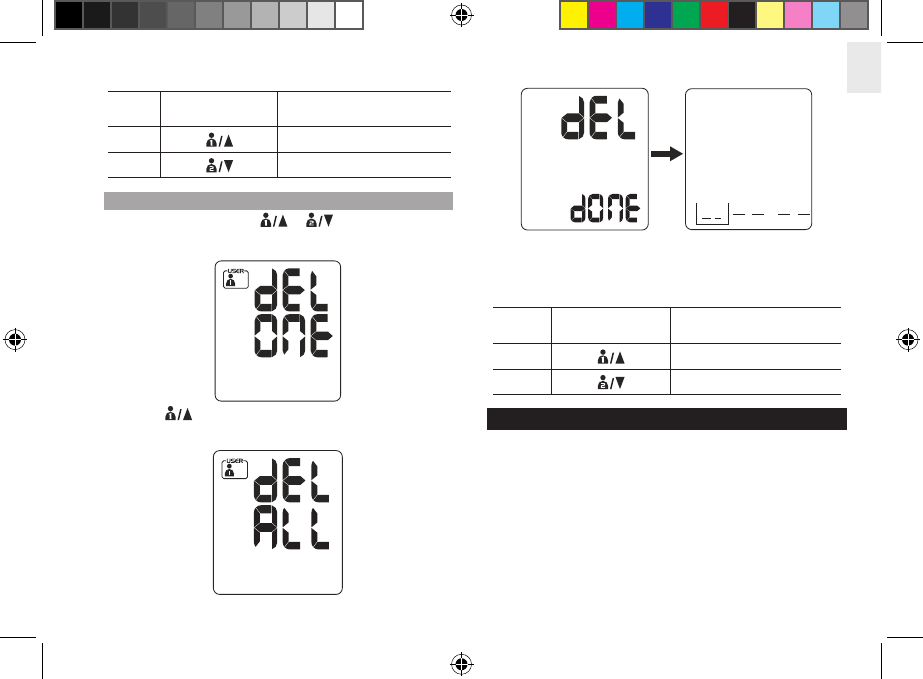
EN
11
b. If you decide to abort the delete action instead
FOR ACTION RETURN TO SCREEN
DISPLAY
User 1 Press twice User 1 records displayed
User 2 Press once User 2 records displayed
DELETING ALL RECORDS
1. When unit is off, press or to select user.
2. Press and hold SET. “deL OnE” will be displayed on the
LCD screen.
3. Press to select option to delete all records (“del All”
will appear on the screenv).
4. a. Press and hold SET again to delete all records.
MEM
no
The “deL dOnE” screen followed with the “no -–“ screen
indicates all records have been successfully deleted and
there are no records in memory.
b. If you decide to abort the delete action instead
FOR ACTION RETURN TO SCREEN
DISPLAY
User 1 Press once User 1 records displayed
User 2 Press twice User 2 records displayed
DATA TRANSMISSION
To help users keep track of their results, the measurements
recorded by BPW800 can be easily uploaded to the network
for viewing and analysis.
For added convenience, the unit is programmed to send
data automatically:
- after taking measurement
- after viewing records and unit detects there is data which
was not sent successfully
- at midnight everyday.
User can also choose to manually send data.
BPW800_EN_R8.indd 11 2011/6/8 7:07:09 PM
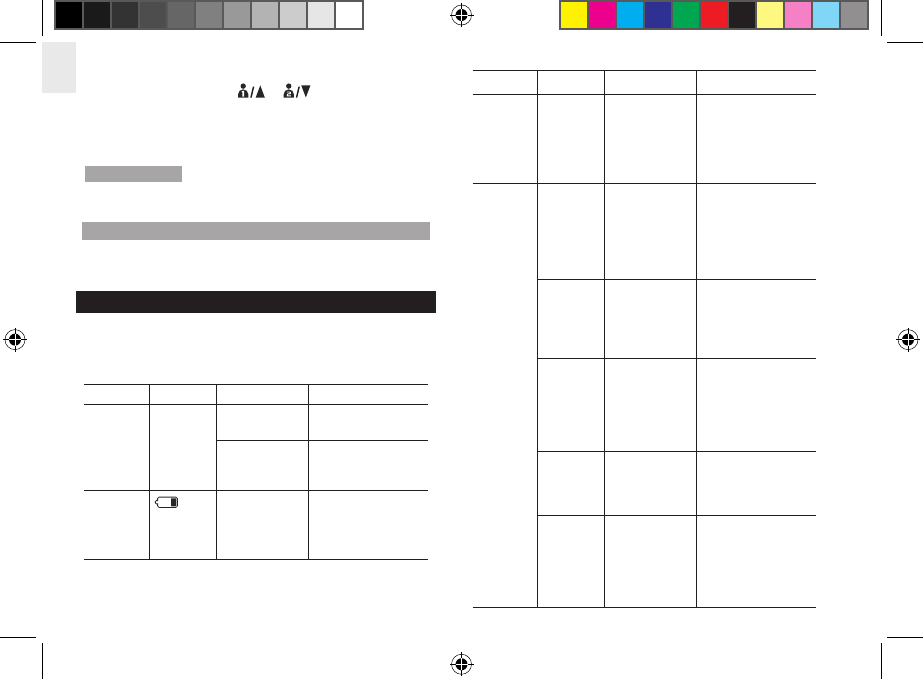
EN
12
To manually send data:
1. When unit is off, press or .
2. When screen appears, press SET.
DONE indicates successful data transmission.
Err indicates unsuccessful data transmission.
IMPORTANT To prevent records being erased before
being uploaded to the network, users are reminded to send
data when there are 24 records.
UNIQUE DEVICE ID
Each unit has a unique device ID which can be found on
the device.
TROUBLESHOOTING
This section includes a list of error messages and frequently
asked questions for problems you may encounter with your
blood pressure monitor. If the product is not operating as you
think it should, check here before arranging for servicing.
Problem
Symptom
Check This
Remedy
No
power
Display
is dim or
will not
light up
Batteries are
exhausted
Replace with new
batteries
Batteries
are inserted
incorrectly
Insert the batteries
correctly
Low
batteries
shows
on the
display
Batteries are
low
Replace with new
batteries
Problem
Symptom
Check This
Remedy
Memory
full
warning
Flashing
MEM
appears
on the
display
24 or more
records per
user have
not been
uploaded
Upload the data
to the network
(refer to DATA
TRANSMISSION).
Error
message
Err
appears
on the
display
A measure-
ment error
occurred;
Data
transmission
failed
Relax for a
moment and then
measure again ;
Move closer to the
hub and reattempt
to send data
Err 1,
2, or 3
appears
on the
display
The wrist cuff
is not secure
Refasten the cuff
and then measure
again
Err 4
appears
on the
display
The monitor
detected
motion while
measuring
Movement
can affect the
measurement.
Relax for a
moment and then
measure again
Err 5
appears
on the
display
Pressure is
over
37.3kPa (280
mmHg)
Relax for a
moment and then
measure again
Err 6
appears
on the
display
Deation
period was
too long
Movement
can affect the
measurement.
Relax for a
moment and then
measure again
BPW800_EN_R8.indd 12 2011/6/8 7:07:10 PM
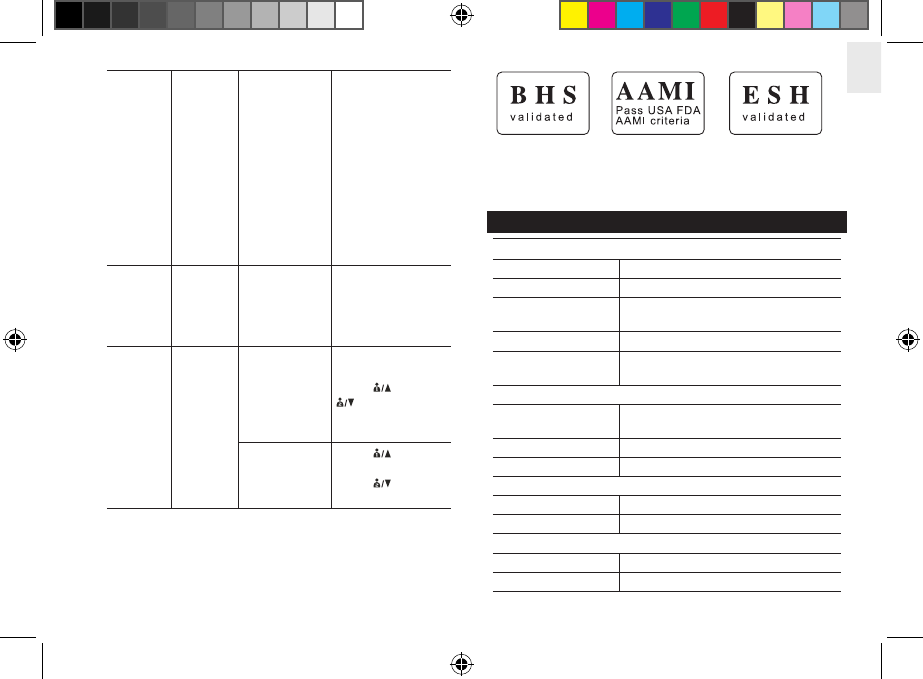
EN
13
British
Hypertension
Society
Association for the
Advancement of
Medical
Instrumentation
European Society
of Hypertension
TECHNICAL SPECIFICATIONS
Application
Measuring method
Oscillometric / non-invasive
Application
For adult use only
Measurement
location
Wrist section of lower arm
Memory
Maximum 30 records per user
Maximum number
of users
2
Dimensions
Height x Width x
Depth
3.5 x 3.4 x 1.2 inches
(90 x 86 x 30.8 mm)
Weight
6.3 oz (180g) without batteries
Cuff circumference
5.3 to 7.7 inches (13.5 to 19.5 cm)
Measuring range
Pressure
30 to 280 mmHg (4.0 to 37.3 kPa)
Pulse
40 to 200 pulse/min
Accuracy
Pressure
+/- 3 mmHg (+/- 0.4 kPa)
Pulse
+/- 5%
Error
message
EExx
appears
on the
display
A calibration
error
occurred
Retake the
measurement.
If the problem
persists, contact
the retailer or our
customer service
department
for further
assistance. Refer
to the warranty
for contact
information and
return instructions
Settings
are
wrong
Date and
time are
incorrect
The clock
was not set
or reset after
installing new
batteries
Reset the clock
No user
memory
Cannot
nd a
record
The memory
was not
saved after
taking a
measurement
Retake the
measurement.
Press or
to save the
corresponding
user’s memory
The record
was stored
to the wrong
user memory
Press to view
User 1’s record.
Press to view
User 2’s record
BPW800_EN_R8.indd 13 2011/6/8 7:07:11 PM
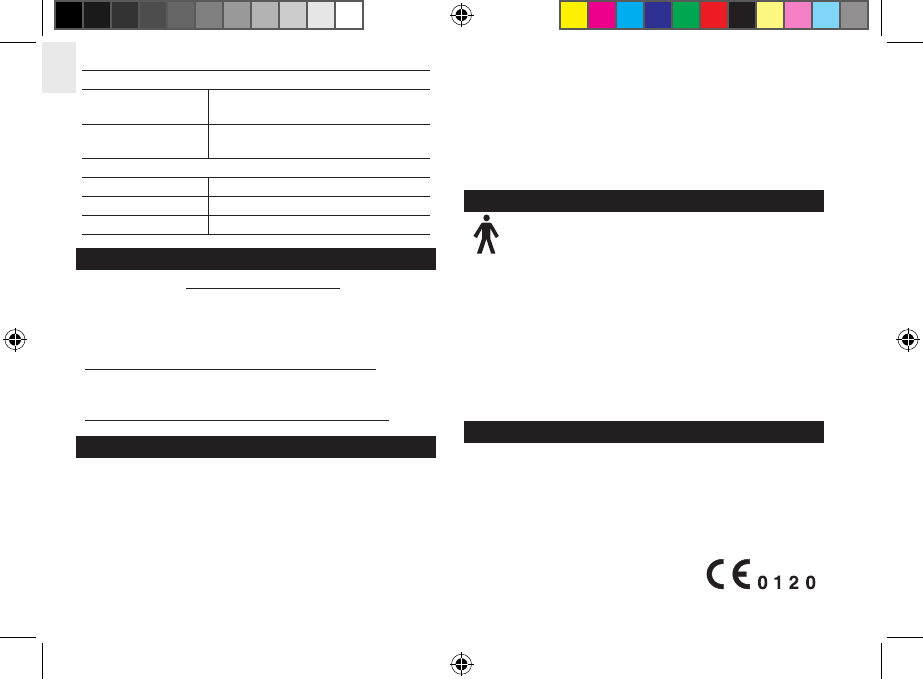
EN
14
Power
Power supply
3V DC, 2 LR03 / AAA / UM4-size
1.5V batteries
Power save
Auto power off after 1 minute of
non-activity
Operating environment
Operation
50°F to 104°F (10°C to 40°C)
Storage / Transport
-4°F to 140°F (-20°C to 60°C)
Humidity range
10% to 83% relative humidity
ABOUT OREGON SCIENTIFIC
Visit our website (www.oregonscientic.com) to learn more
about Oregon Scientic products.
If you’re in the US and would like to contact our Customer
Care department directly, please visit:
https://us.oregonscientic.com/service/support.asp
For international inquiries, please visit:
http://us.oregonscientic.com/about/international.asp
INFORMATION ABOUT THE CE MARK
This device complies with the European regulations based
on the Medical Products Code, and bears the CE mark
“CE0120”. The device has been quality inspected according
to EU guideline 93/42/EEC and tested in compliance to
the “EN1060-1 Non-invasive sphygmomanometers - Part
1, General requirements” and “EN1060-3 Non-invasive
sphygmomanometers-Part3: Supplementary requirements
for electromechanical blood pressure measuring systems”.
The CE mark further indicates that this blood pressure
monitor meets the general requirements for electronic
products as regards to resistance to electromagnetic
interference. Malfunctioning may however occur in the
proximity of extremely strong electromagnetic elds. In
accordance with the “Ordinance for Operators of Medical
Products”, a technical inspection must be carried out if this
device is used for industrial or commercial purposes.
SYMBOL DESCRIPTION(S)
Type B Equipment
Reference
Enterprise Production Guangdong Food and Drug
License No. Monitoring Machinery
Production License No.
20010422
Standard Registration YZB/ Guangdong 0108-2008
Serial No.
Standard Enterprise Q/SZK 01-2006
Serial No.
BLOOD PRESSURE LOG BOOK
To create a log of your blood pressure history, complete the
personal information section at the top, then enter the details
(date, time, and measurements) for each reading you take.
To plot your history, use an S (systolic), D (diastolic) and
M (mean arterial pressure) to mark the points where each
measurement falls on the chart, then connect the points to
view your history over time
Protected by US. Patent no. 7,211,047
BPW800_EN_R8.indd 14 2011/6/8 7:07:12 PM
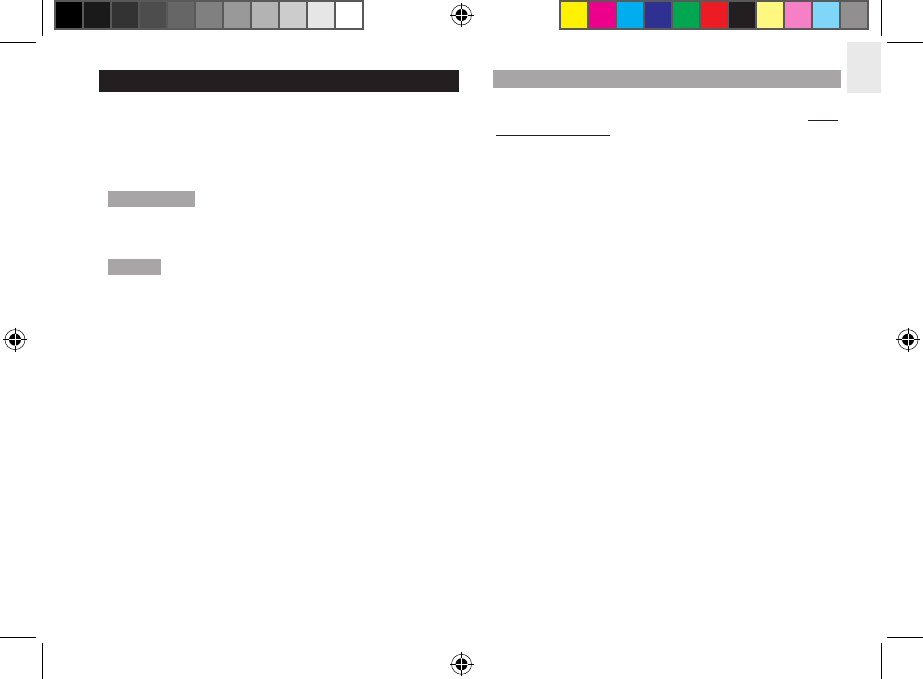
EN
15
FCC STATEMENT
This device complies with Part 15 of the FCC Rules.
Operation is subject to the following two conditions: (1) This
device may not cause harmful interference, and (2) This
device must accept any interference received, including
interference that may cause undesired operation.
WARNING Changes or modications not expressly
approved by the party responsible for compliance could void
the user’s authority to operate the equipment.
NOTE This equipment has been tested and found to
comply with the limits for a Class B digital device, pursuant
to Part 15 of the FCC Rules. These limits are designed to
provide reasonable protection against harmful interference
in a residential installation.
This equipment generates, uses and can radiate radio
frequency energy and, if not installed and used in accordance
with the instructions, may cause harmful interference to
radio communications. However, there is no guarantee
that interference will not occur in a particular installation.
If this equipment does cause harmful interference to radio
or television reception, which can be determined by turning
the equipment off and on, the user is encouraged to try
to correct the interference by one or more of the following
measures:
• Reorient or relocate the receiving antenna.
• Increase the separation between the equipment and
receiver.
• Connect the equipment into an outlet on a circuit
different from that to which the receiver is connected.
• Consult the dealer or an experienced radio / TV
technician for help.
DECLARATION OF CONFORMITY
The following information is not to be used as contact
for support or sales. Please visit our website at www.
oregonscientic.com for all enquiries.
We
Name: Oregon Scientic, Inc.
Address: 19861 SW 95th
Ave.,Tualatin,
Oregon 97062 USA
Telephone No.: 1-800-853-8883
declare that the product
Product No.: BPW800
Product Name: Talking Blood Pressure Monitor
Manufacturer: IDT Technology Limited
Address: Block C, 9/F, Kaiser Estate,
Phase 1,41 Man Yue St.,
Hung Hom, Kowloon,
Hong Kong
is in conformity with Part 15 of the FCC Rules. Operation is
subject to the following two conditions: 1) This device may
not cause harmful interference. 2) This device must accept
any interference received, including interference that may
cause undesired operation.
BPW800_EN_R8.indd 15 2011/6/8 7:07:12 PM
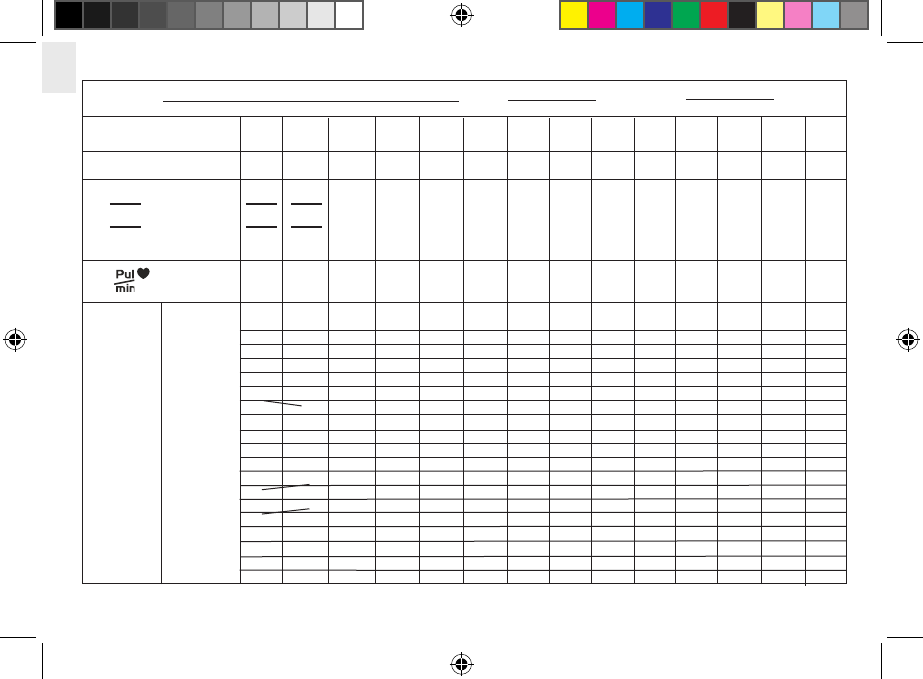
EN
16
10 17
Name: Age: Weight: (kg/lbs)
Date
Time
SYS
DIS
MAP
158
90
110
155
95
112
S
S
MM
OO
OCT OCT
10PM 10PM
8.0
10.7
13.3
16.0
18.7
21.3
24.0
26.7
29.3
85 90
60
80
100
120
140
160
180
200
220
kPa mmHg
BPW800_EN_R8.indd 16 2011/6/8 7:07:13 PM